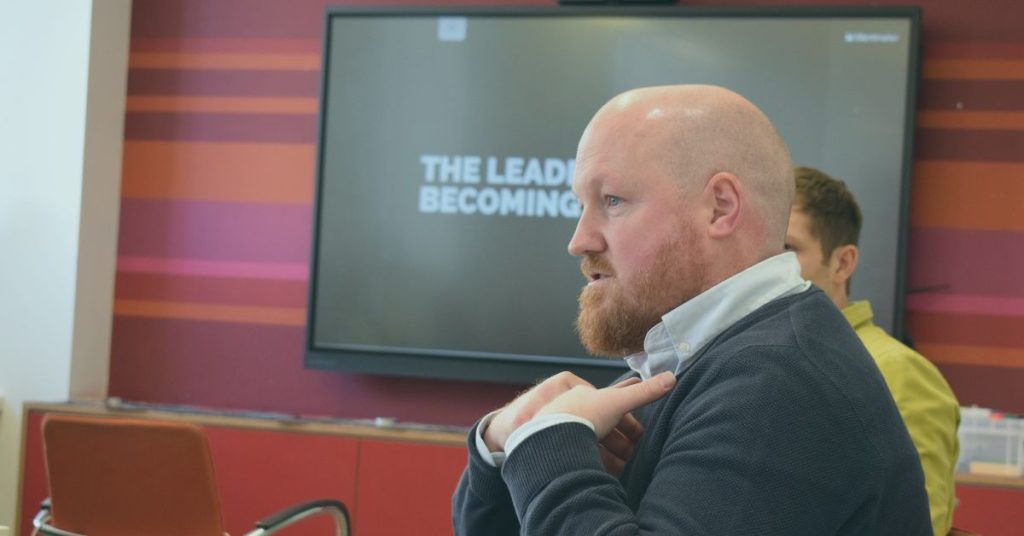About the author: Stephen Moreton’s journey from professional sport, to a national head coach and then educator gave him a great platform to work and influence at the highest levels in business. He loves leading and facilitating change, particularly in high performance.
What are some of the biggest challenges you face as a facilitator?
My biggest challenge is to make sure that the experience of every person who enters the room is safe, relevant, and meaningful. It is hard work trying to connect with everyone in the room and make space for people to feel comfortable, but if we can get there it is incredibly rewarding.
What are some of the opportunities you see for participants as a facilitator?
Participants are often faced with a decision; do I fully engage in this, or do I sit back and be detached, taking the time as a break from their day to day? Sometimes there is chaos outside of the room, and it can be challenging to engage, but as the saying goes “you only get out what you put in”. So, the more open and engaged participants are willing to be, usually determines the amount of learning they experience.
Can you share a memorable or impactful experience you’ve had as a facilitator, and how it influenced your work?
Most, if not all groups start off quite tentatively. A wise colleague called this “ritual sniffing”. Being able to break through that, and build a safe, strong, and intimate connection is critical. The most rewarding experiences have been when the group has that moment of “are we in?” and because of the energy you have facilitated – it feels like there is a collective moment where people buy-in to share a powerful, and honest experience together.
How do you tailor your approach to different types of clients and situations?
Every partner, every tier of leader or team, and even every cohort or group of people has a different identity. I believe it is more important to be adaptable to the personalities in the group, the identities and the motivations of the group and ensuring that I understand that and facilitate what it is they are looking for. Internally, I am conscious of the importance of trusting myself, that “I am enough,” and that my humility, curiosity, and integrity will allow me to embrace any scenario.
What resources do you rely on in your own professional development?
I seek out people who I admire, I observe and I regularly ask for feedback – mainly on the impact: did it meet my intentions? I also love reading.
What resources do you rely on heavily as a facilitator that you see create impact in the room?
Sitting and listening to an expert has a small place in learning, but the time of reading lines on slides is over. People want their learning to be about them and involve them. So, the resources I look for, and trust, are those that help make a deep and meaningful impact on others – without being reliant upon me personally to draw meaning.
How do you see the leadership development field evolving?
Organizations that continually invest in their people and believe people are the solution to the ever-increasing demands, are likely to be more curious about how to provide, inspire and grow their people. In return these people will likely give back trust, investment, and opportunities they have received to their business. Sadly, not all see it this way and are primarily focused on numbers and scale – so are often de-personalising the learning experiences, and removing personal connection, or the ability to go deep and be intimate. What business views as a short-term cost, is ultimately a long-term investment in their people and their culture. The more they invest…?
How do you ensure everyone’s voice is heard? How do you manage group dynamics?
I think you must accept initially that it is unlikely that everyone’s voice will be heard equally. And then you try your hardest to create that space and environment anyway. The physical environment is important, and the design is critical. The more purposeful, compassionate, and connected the design, then the opportunities for inclusion and empathy in the group are stronger. Once we are in the room, my focus changes to observing and sensing the group and how each person is responding – this enables flexibility with pace, depth, involvement, self-reflection, or activity. There are many ‘tactics’ but ultimately the key, for me, is to connect my energy and intuition to the group and deeply pay attention to each individual.
How do you foster a sense of trust and collaboration amongst participants?
One element that is outside of my control, is each participant’s attitude and openness, if someone is closed or fixed for whatever reason it can be challenging, but the intention is always to “catch people in” not “catch people out.” Establishing a social contract at the outset and holding people accountable to that creates a sense of trust. Initially, there is often scepticism, sometimes fear or apathy – but it is rare for people to connect intimately with a group, so once that energy builds – people often choose to be open and enjoy the experience. However, when boundaries are crossed in the room, or sometimes after the room has closed – that presents an opportunity and a challenge.
How do you address resistance or scepticism from participants who may be hesitant to engage in the process?
There are many ways we can ‘catch people in.’ Some people are not aware of their mindset, so finding a way to lift that level of awareness is usually very powerful and impactful. More challenging is if someone is intentionally providing resistance or scepticism. My approach is to have empathy for that person, and what might be causing that attitude and behaviour and to understand how to help that person have a more positive impact on the group experience, give space to their concerns, but also facilitate an experience that recognises the frustration or feeling.
How do you balance the need to guide the group towards a specific outcome with the need to allow for discussion and exploration of ideas?
It is critical to understand the purpose and the desired outcomes before the learning experience begins. How we get to that point is different for every group, and every participant within it. I am not one for rigidly sticking to time, but I am conscious of what the key pillars or elements will help the experience become coherent. My approach is to flex with the needs of the group, and the people – give more time and space to the matters critical to them, but also give individuals the ball of responsibility. Ultimately, there is no learning that can take place in 3 hours, or in 6, that will give all the answers of a lifetime. My job is to engender the curiosity for people to explore what matters to them as a person and a leader.
Book a meeting with Stephen Moreton.


